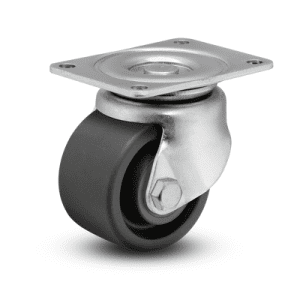 There are many different types of casters (far more than you could possibly imagine) in this world, actually! Casters are suited to many types of applications and environments. All the important component parts – the mount, the wheel, the tread and the plate – can all be manufactured from different materials and designed in different ways to perform multiple tasks.
There are many different types of casters (far more than you could possibly imagine) in this world, actually! Casters are suited to many types of applications and environments. All the important component parts – the mount, the wheel, the tread and the plate – can all be manufactured from different materials and designed in different ways to perform multiple tasks.
This article will take a look at flat free casters – how they are designed, how they are put together, and what applications are more suited to their use.
What Exactly is a Flat Free Caster?
If you’ve ever driven a car, or ridden a bicycle, then you will know the pain of a flat tire. Tires were invented in the late 1800s by a Scottish engineer named Robert W. Thomson, but he did not have the business expertise to make a success of his invention. Thomson’s design was later improved by John Boyd Dunlop, and of course Dunlop tires are well known right up to the present day.
Common Types of Tires
The most common type of tire is the pneumatic tire. The word ‘pneumatic’ is derived from the French word ‘pneumatique’ which itself comes from the Greek word for ‘wind’. A pneumatic tire is one that is inflated to give a continuous cushion of air between the road surface and the wheel. Before the invention of the pneumatic tire, tires were made of solid materials, leading to very uncomfortable transportation!
Pneumatic tires are also used on many types of casters, and while pneumatic casters have many advantages, they also have a couple of disadvantages:
- In order for them to perform at their best, they have to be kept inflated to the recommended pressure.
- Sharp objects can embed themselves in the tread and puncture the tire, leading to a loss of pressure and of course, a flat tire.
With a car or bicycle, a flat tire is simply an annoyance that can quickly be fixed. With a caster, a pneumatic tire that deflates quickly can be something that’s much more than an annoyance – it can be a danger. An item with a flat tire on a caster can unbalance and tip with very serious consequences.
A Solution?
One way you can prevent such an accident while maintaining the convenience of having ‘pneumatic’ tires is by using what’s referred to as a flat free caster. Such casters are called ‘flat free’ as they have solid tires which therefore cannot puncture or deflate.
How a Flat Free Caster is Constructed
Flat free casters really do look exactly like pneumatic casters but they are usually made from solid polyurethane or rubber or some other suitable material, and they have tread that is commonly found on pneumatic casters. Tires are simply molded in such a way that they resemble pneumatic tires. They are then fixed onto the caster wheel then housed into the caster mount to complete the construction process.
Choosing flat free casters also has both advantages and disadvantages:
Advantages of using Flat Free Casters
- Naturally, the main advantage of a flat free caster over a pneumatic tire is that a flat free tire can never puncture! This is ideal if you work in an environment where there is typically a lot of debris on floors, and some of it has the potential to be sharp enough to create punctures. If your items that are caster-mounted are heavy, then you don’t want to risk having them tip. A flat free caster typically means that punctures are never a problem.
- With flat-free casters you do not have to worry about inflating the tires, as there is nothing for you to inflate!
Disadvantages of Flat Free Casters
- The main disadvantage with a flat-free tire is that they simply do not roll as well as pneumatic tires. Think about it – would you rather ride a bicycle with pneumatic tires or solid ones? Of course, if you keep your bicycle tires inflated to the correct pressure then they should feel ‘rock solid’, but there is always that slight amount of cushioning, no matter how hard your tires become. With flat-free tires there is a certain amount of cushioning with some materials (i.e. rubber) but much less with others (for example, polyurethane). This means that such casters can be harder to roll.
Like most things in life, investing in flat-free casters is a tradeoff between the advantages and disadvantages of such a product.
The Best Environments to Use Flat Free Casters
As mentioned above, flat-free casters are a superb choice in environments that have a lot of debris on the floor. Flat-free tires give you most of the advantages of pneumatic tires without the worry of punctures. You still need to keep your flat free tires free from debris in order for them to maintain successful operation.
Flat-free tires also perform well in extreme conditions, such as very hot and very cold places within moderation. They are also resistant to chemicals, and have non-marking properties. If any of these are important considerations in your company’s operations, then making the choice of flat-free tires is one of the best decisions you will likely ever make.
Douglas Equipment. The Place to Purchase Flat Free Tires
Contact a Douglas Equipment our sales support staff if you are considering the purchase of flat-free casters. Each member of our team has years of expertise and will be happy to help you with any questions you may have.
Call 1-800-451-0030, or reach us through our online contact form on our website today!




